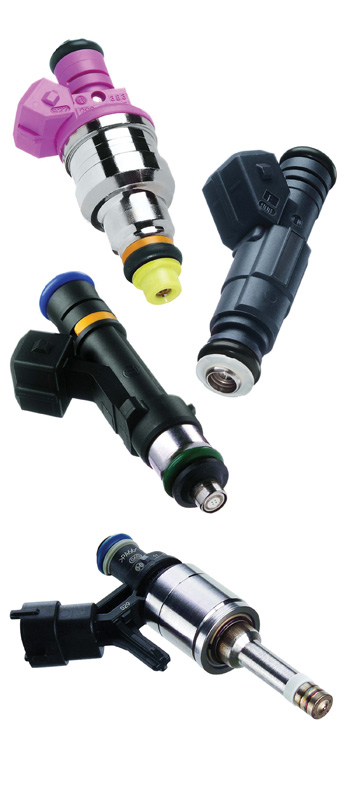Fuel pumps, injectors and pressure regulators are the three most commonly replaced fuel system components. Problems with any of these may prevent an engine from starting or cause serious drivability or performance problems.
 Fuel pump failures can be caused by electrical faults, old age (wear) or fuel contaminants (dirt, moisture or bad gas). Fuel pump failures often occur without warning. Many so-called pump failures are also misdiagnosed. The pump is still good but is not working because it is not receiving voltage because of a bad relay, fuse or wiring problem. A good pump also can’t deliver normal fuel pressure if pressure regulator has failed, the fuel filter is clogged or the fuel line has a restriction.
Fuel pump failures can be caused by electrical faults, old age (wear) or fuel contaminants (dirt, moisture or bad gas). Fuel pump failures often occur without warning. Many so-called pump failures are also misdiagnosed. The pump is still good but is not working because it is not receiving voltage because of a bad relay, fuse or wiring problem. A good pump also can’t deliver normal fuel pressure if pressure regulator has failed, the fuel filter is clogged or the fuel line has a restriction.
Most fuel pumps are located inside the fuel tank, and are part of a module assembly that includes the fuel level sending unit and float. On vehicles with “returnless” EFI systems, the pressure regulator also is part of the module assembly. The fuel filter also may be part of the module.
The fuel pump module is held in place with fasteners or a lock ring on top of the fuel tank, which requires dropping the tank if the pump needs to be replaced. The gasket or O-ring seal should always be replaced when changing the pump, along with the filter sock on the pump inlet. Wiring connections also should be cleaned and inspected to assure good electrical contact.
On many vehicles, the fuel pump can be replaced separately from the module, but it is usually faster and easier to replace the whole module. Replacing the entire module also reduces the risk of problems down the road if the original sending unit is worn, corroded or not providing an accurate signal to the fuel gauge.
Most newer vehicles use a “turbine”-style fuel pump. A turbine pump has an impeller ring attached to the motor. The blades in the impeller push the fuel through the pump as the impeller spins. This type of pump is not a positive-displacement pump, so it produces no pulsations, runs very smoothly and quietly. It also is less complicated to manufacture and is very durable. Some aftermarket pump suppliers use this type of pump to replace the older roller and vane style pumps.
A replacement fuel pump does not have to be the same type as the original as long as it is capable of generating the same pressure and flow as the original.
Fuel injector problems include clogging (buildup of fuel varnish inside the nozzle), wear (high-mileage injectors) and electrical faults. Dirty injectors can cause misfiring and poor performance. Cleaning with fuel additives or direct cleaning can often restore normal operation. But if an injector has completely clogged, is badly worn or has stopped functioning due to an internal electrical fault, it will have to be replaced with a new or remanufactured injector.
Injectors are expensive to replace in complete sets, so a customer may be reluctant to replace all of his injectors if only a few are bad. On a high-mileage vehicle, this can be asking for trouble down the road because if one or more injectors have clogged or failed, chances are the other injectors will soon be causing problems, too.
Fuel pressure regulators control fuel pressure to the injectors. The regulator is usually located on the fuel supply rail that feeds the injectors, but will be mounted in the tank on a returnless EFI system.







